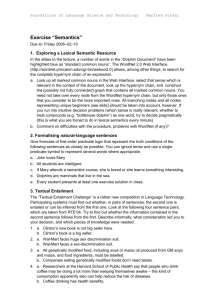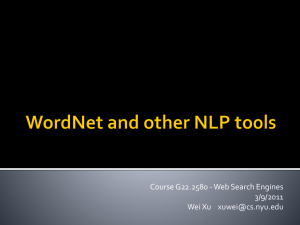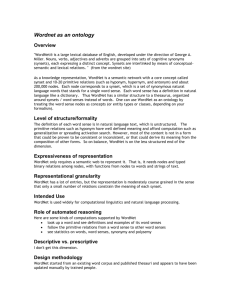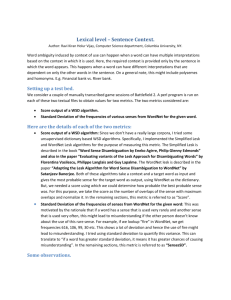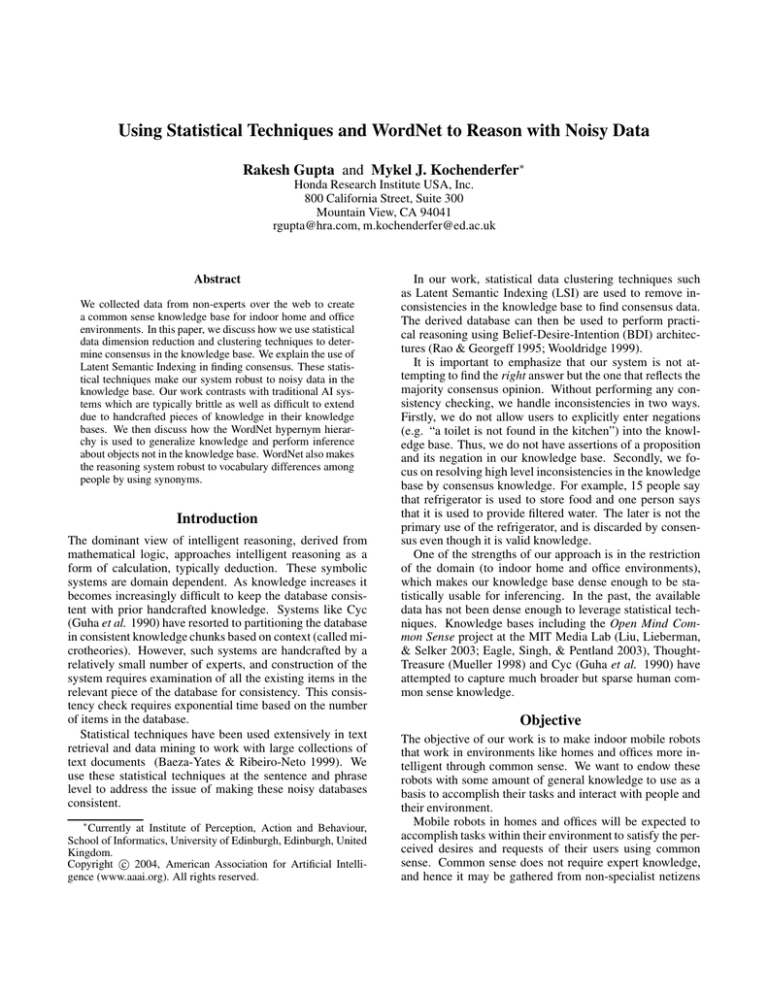
Using Statistical Techniques and WordNet to Reason with Noisy Data
Rakesh Gupta and Mykel J. Kochenderfer∗
Honda Research Institute USA, Inc.
800 California Street, Suite 300
Mountain View, CA 94041
rgupta@hra.com, m.kochenderfer@ed.ac.uk
Abstract
We collected data from non-experts over the web to create
a common sense knowledge base for indoor home and office
environments. In this paper, we discuss how we use statistical
data dimension reduction and clustering techniques to determine consensus in the knowledge base. We explain the use of
Latent Semantic Indexing in finding consensus. These statistical techniques make our system robust to noisy data in the
knowledge base. Our work contrasts with traditional AI systems which are typically brittle as well as difficult to extend
due to handcrafted pieces of knowledge in their knowledge
bases. We then discuss how the WordNet hypernym hierarchy is used to generalize knowledge and perform inference
about objects not in the knowledge base. WordNet also makes
the reasoning system robust to vocabulary differences among
people by using synonyms.
Introduction
The dominant view of intelligent reasoning, derived from
mathematical logic, approaches intelligent reasoning as a
form of calculation, typically deduction. These symbolic
systems are domain dependent. As knowledge increases it
becomes increasingly difficult to keep the database consistent with prior handcrafted knowledge. Systems like Cyc
(Guha et al. 1990) have resorted to partitioning the database
in consistent knowledge chunks based on context (called microtheories). However, such systems are handcrafted by a
relatively small number of experts, and construction of the
system requires examination of all the existing items in the
relevant piece of the database for consistency. This consistency check requires exponential time based on the number
of items in the database.
Statistical techniques have been used extensively in text
retrieval and data mining to work with large collections of
text documents (Baeza-Yates & Ribeiro-Neto 1999). We
use these statistical techniques at the sentence and phrase
level to address the issue of making these noisy databases
consistent.
∗
Currently at Institute of Perception, Action and Behaviour,
School of Informatics, University of Edinburgh, Edinburgh, United
Kingdom.
c 2004, American Association for Artificial IntelliCopyright gence (www.aaai.org). All rights reserved.
In our work, statistical data clustering techniques such
as Latent Semantic Indexing (LSI) are used to remove inconsistencies in the knowledge base to find consensus data.
The derived database can then be used to perform practical reasoning using Belief-Desire-Intention (BDI) architectures (Rao & Georgeff 1995; Wooldridge 1999).
It is important to emphasize that our system is not attempting to find the right answer but the one that reflects the
majority consensus opinion. Without performing any consistency checking, we handle inconsistencies in two ways.
Firstly, we do not allow users to explicitly enter negations
(e.g. “a toilet is not found in the kitchen”) into the knowledge base. Thus, we do not have assertions of a proposition
and its negation in our knowledge base. Secondly, we focus on resolving high level inconsistencies in the knowledge
base by consensus knowledge. For example, 15 people say
that refrigerator is used to store food and one person says
that it is used to provide filtered water. The later is not the
primary use of the refrigerator, and is discarded by consensus even though it is valid knowledge.
One of the strengths of our approach is in the restriction
of the domain (to indoor home and office environments),
which makes our knowledge base dense enough to be statistically usable for inferencing. In the past, the available
data has not been dense enough to leverage statistical techniques. Knowledge bases including the Open Mind Common Sense project at the MIT Media Lab (Liu, Lieberman,
& Selker 2003; Eagle, Singh, & Pentland 2003), ThoughtTreasure (Mueller 1998) and Cyc (Guha et al. 1990) have
attempted to capture much broader but sparse human common sense knowledge.
Objective
The objective of our work is to make indoor mobile robots
that work in environments like homes and offices more intelligent through common sense. We want to endow these
robots with some amount of general knowledge to use as a
basis to accomplish their tasks and interact with people and
their environment.
Mobile robots in homes and offices will be expected to
accomplish tasks within their environment to satisfy the perceived desires and requests of their users using common
sense. Common sense does not require expert knowledge,
and hence it may be gathered from non-specialist netizens
in the same fashion as the projects associated with the rather
successful Open Mind Initiative pioneered by David Stork
(Stork 1999; 2000). The raw data collected over the web is
processed using statistical techniques and WordNet to populate an initial robot knowledge base. In the future, these
robots will be able to learn through human interaction and
other methods and add to their knowledge bases online.
In the next section, we describe our framework for capturing template data using Open Mind and our database
schema. We then explain how we use Latent Semantic Indexing to prune our database to data reflecting consensus.
We then discuss how we use WordNet to generalize our
knowledge and to further make it independent of vocabulary. Finally, we discuss our conclusions and future work.
and focuses on the role that intentions play in practical reasoning. It is founded upon established theory of rational action in humans.
Beliefs correspond to information the agent has about the
world. Given F , sensor observations, and a belief revision
function, current beliefs can be determined. Desires represent states of affairs that the agent would (in an ideal world)
wish to be brought about. Current beliefs and I provide a
list of current desires. In addition, humans may also explicitly assign goals (desires) to the robot. Intentions represent
desires that it has committed to achieving. Desires can be
filtered by a deliberation function to give current intentions
that are then acted upon by the robot.
Knowledge Capture Framework
We first collected the names of objects commonly found in
homes and offices. We started with a collection of photographs of such objects, and users identified them by entering their corresponding names into a form. Users were
also prompted to enter new object names by forms like An
object found in the office is
.
Once some objects were collected, we asked users to identify various properties of an object. For example, the user
might be prompted A microwave is often
. Or, the
user might be prompted People sometimes desire that a cup
. From this data, the system built a
of coffee is
collection of object attributes.
From these statements, the system constructed questions
about causality. For example, a form asked A plant is healthy
when a
is
. The response of the user
was then transformed into an implication and added to the
set F and stored in the system’s database.
We gathered information about indicators of desires. For
example, a form asked, You might want a dvd player
to be plugged into a television if you notice that your
has become
. The entries for the
blanks were stored as an implication in the set I.
Common sense knowledge about the location of common
objects is required to perform actions on objects in the home
or office. For example, if we want the robot to make a cup of
coffee, it would be useful for the robot to know that coffee
makers tend to be found in kitchen and that milk is usually
stored in the refrigerator. We therefore had activities where
netizens could indicate typical object location and pairs of
objects that are generally found together.
Other common sense knowledge we collected included
knowledge about uses of different objects and activities of
people. All this data was collected over the web from nonexperts through forms hosted on the Open Mind website.
More details about Open Mind Indoor Common Sense data
collection is described in Gupta & Kochenderfer (2004).
In this section, we describe the common sense knowledge base, the various implications used, and the database
schema. We also provide examples of template-based forms
for collecting common sense knowledge.
To capture relations, it would be easiest to have the users
enter statements of the form (object , property), but this
would be unnatural for the user. The other extreme would
be to accept phrases in natural language and later parse them
using lemmatization and part-of-speech tagging. We decided to take an intermediate approach using sentence templates where the user is prompted with a natural language
sentence with some blanks. Users enter words or phrases
to complete these sentences (as in many of the other Open
Mind Initiative projects).
Knowledge Base Implications
The framework of this work is object-centric. It is assumed
that the desires of the users and the actions taken by the robot
are grounded in the properties of objects in the world.
In our system, a statement is a pair φ = (o, p) where o is
the object and p is a verb or adjective. For example, a user
may wish that her coffee be heated. In this case, the object of
the desire is coffee and the desired property is heated. The
representation of this statement would be (coffee, heated ).
Statements can also be thought of as actions. For example,
(coffee, heated ) represents the action that causes coffee to
be heated. The robot is capable of explicitly executing some
set of actions represented in our system as statements.
One statement implying (or causing) another is represented as: φ1 → φ2 . For example, we might have the implication (trash, in trash can) → (house, clean). We shall
denote the collection of all implications of this form by F .
One statement can indicate a desire represented by the
second statement. Symbolically, this implication is represented as: φ1 →d φ2 . For example, we might have the implication (stomach, growling ) →d (human, fed ). We shall
denote the collection of all such implications used to anticipate human desires by I.
This knowledge base can be used for common sense and
practical reasoning using Belief-Desires-Intentions (BDI)
theory. BDI was originally developed by Bratman (1987)
Relational Common Sense Knowledge
Database Schema
Open Mind data collection is schematically shown in figure 1. All knowledge entered into the website goes through
a review process by an administrator. Once accepted,
these structured responses are transformed into relations and
saved in the database. These relations are then used to generate new sentence templates.
Generate
new sentence
templates
Common Sense
Knowledge Base
Convert
to
relations
Save as raw
sentences
Review
Figure 1: Schematic for Open Mind data collection.
A MySQL database is used to store the data collected
from the website. Raw sentences are archived in a table
with the following schema.
Entries(id, userid, date, sentence,
status, activity, form)
When a user enters new knowledge, its status is uncommitted. An administrator is later able to commit (or reject)
the entry to the database. Committing an entry transforms
the sentence and populates one or more of the following relations:
Objects(id, name)
Statements(id, obj, prop, desire)
Uses(id, obj, vp)
Causes(id, obj1, prop1, obj2, prop2)
Desires(id, obj1, prop1, obj2, prop2)
Rooms(id, name)
Proximity(id, obj1, obj2)
Locations(id, obj, room)
We use statistical techniques like LSI to clean up that raw
knowledge base. Once data is cleaned up and compacted using WordNet, these relations are used to answer user posed
text queries about object location and their use in various
tasks.
Latent Semantic Indexing for finding
consensus
Luhn (1961) proposed the idea of notional families to group
together words of similar and related meaning. We can
view Latent Semantic Indexing (LSI) as a similarity measure that makes judgements based on word co-occurrence.
Such co-occurrence has been used as an indicator of topic
relatedness in document analysis (Deerwester et al. 1990;
Scott & Matwin 1999), but in our work, we use it to analyze
phrases. In latent semantic space, phrases that are semantically similar according to the co-occurrence analysis are
clustered together. We select the primary cluster as the one
reflecting consensus.
To prepare the data for LSI, we first run a spell-check on
the web-collected data and correct spellings. We then analyze the sentences to remove frequent words using a stopword list to reduce the feature set size, and then we perform stemming. Stemming maps word variants to the same
feature (e.g. cooking, cooked, cooks maps to same word
cook). We then apply LSI via Singular Value Decomposition (SVD) to find the most relevant sentence cluster. The
computation of SVD is quadratic in the rank of the term by
sentence matrix and cubic in the number of singular values
that are computed (Manning & Schuetze 2001).
For example, in our database following is the raw data
collected for the template A cup is used to
.
get the right amount of an ingredient when cooking
drink tea
hold tea
drink out of
hold a drink
serve tea
hold coffee
drink coffe from
drink coffee
drink from
drink
drink and hold tea
holding tea
drink from
hold coffee
store items
wake up in the morning
store dishes
keep awake
The entry coffe is replaced by the word coffee in the spellcheck phase. The stop words of, a, from, when, up, in, the
and an get filtered out. Stemming maps hold and holding to
the same root word hold. Thus, after preprocessing steps we
get the following terms:
1. hold
2. tea
3. drink
4. out
5. serve
6. coffee
7. get
8. right
9. amount
10. ingredient
11. cook
12. store
000000111110000000
011000000000000000
110000000000000000
001100000000000000
101000000000000000
010010000000000000
100001000000000000
001001000000000000
001001000000000000
001000000000000000
001000000000000000
111000000000000000
110000000000000000
001000000000000000
100001000000000000
000000000001100000
000000000000011000
000000000001000100
000000000000000011
Figure 2: 19 phrase × 18 term matrix for SVD. Each row
corresponds to a particular phrase (e.g. “get the right amount
of an ingredient when cooking”), and the 1’s and 0’s correspond to the presence or absence of a particular term (e.g.
“hold”).
13. item
14. wake
15. morning
16. dish
17. keep
18. awake
This leads to the 19 phrase × 18 term matrix in figure 2.
The first phrase indicates a use for a cup, and the last three
are nonsense options. SVD decomposition clusters phrases
from 2–16 in the clusters represented by the first two singular values. The first phrase shows up in the cluster with
the third highest singular value and the remaining nonsense
phrases in the clusters with the remaining smaller singular
values. Thus LSI helps us select one of the relevant phrases
from 2–16 range. A phrase from this range can be selected
randomly.
It is important to point out that even though we used LSI
for determining consensus, any of the other techniques for
data dimension reduction and clustering such as Spectral
Clustering and Principal Component Analysis (PCA) could
be similarly applied.
While the LSI method deals nicely with the synonymy
problem by clustering them together, it offers only a partial solution to the polysemy problem. That is, a word with
more than one entirely different meaning (e.g. bank) is represented as a weighted average of the different meanings. If
none of the real meanings is like the average meaning this
may cause a severe distortion. In our case polysemy is not
a serious issue because the restriction of the domain heavily
cuts down the number of terms with multiple relevant meanings in the domain.
…
Two objects that you might find in the
same room are: a bottle and a refrigerator.
…
A refrigerator is commonly found in the kitchen.
…
OpenMind Indoor Common Sense Database
Where might I find
a carafe?
Inference
Engine
bottle
beer bottle
carafe
jug
A carafe is found
in the kitchen.
WordNet hyponym hierarchy
Figure 4: Inference using Open Mind and WordNet.
Using WordNet for knowledge compaction and
vocabulary independence
The WordNet lexical database is used to compact the knowledge base to allow the making of inferences about objects
that do not themselves exist in the knowledge base but their
hypernyms or synonyms do.
To illustrate knowledge compaction, suppose our
database contains the fact that spoons are usually found in
the kitchen. Hypernymy is a linguistic term for the is-a relationship, e.g. since a spoon is a cutlery, cutlery is a hypernym of spoon as shown in the WordNet hierarchy for the
noun tableware in Figure 3. In this example, we would ask
if all types of cutlery are usually found in the kitchen. If
the consensus answer is yes, we would replace the knowledge about spoon location with the knowledge about cutlery.
We use the disambiguated sense to determine the appropriate hypernym to query the user.
Knowledge compaction not only saves space but also
makes our knowledge more general. For example, initially
our knowledge base may have the knowledge that “forks
are usually found in kitchen” and “spoons are usually found
in the kitchen”. With knowledge compaction, we remove
knowledge about forks and spoons and replace it with cutlery knowledge. This saves storage space as well as allows
us to infer that table knives are found in the kitchen. We
could not have inferred anything about table knives before
this knowledge compaction.
Since the relations are structured and interconnected, rulebased inference may be applied to produce sentences that
were not explicitly entered into the database. For example,
if the database contains the facts that a spoon is found near
a bowl and a bowl is generally found in the dining room,
the inference engine would be able to infer that a spoon may
be found in the dining room with a certain degree of confidence. Our knowledge base has been used in conjunction
with WordNet to infer the location of objects that were not
found in the database. Users may issue commands using objects that do not explicitly exist in the knowledge base but
are in the WordNet hypernym hierarchy of the object.
root:
tableware
cutlery,
eating utensil
crockery,
dishware
chinaware,
china
flatware
fork
cup
plate
carving fork
dessert plate
chalice, goblet
salad fork
dinner plate
coffee cup
table fork
paper plate
Dixie cup, paper cup,
drinking cup
spoon
soup plate
measuring cup
dessert spoon
platter
teacup
runcible spoon
saucer
soupspoon,
soup spoon
dish
bowl
tablespoon
casserole
teaspoon
serving dish
table knife
Figure 3: Example of a WordNet hierarchy for the noun tableware.
Figure 4 shows an example of inferencing where the
query is: Where might I find a carafe? From the Open Mind
Indoor Common Sense database, after LSI we have:
• Bottle and refrigerator are found together.
• A refrigerator is found in the kitchen.
We can use the WordNet hierarchy and knowledge entered
by netizens to prune irrelevant senses of the word bottle in
the context of indoor environments. From this pruned set
of senses, we can use the information that bottle is a hypernym for carafe from WordNet. We can therefore infer that
a carafe is found in the same place as a bottle, which is the
kitchen.
As another example, the object patchwork was never entered into the knowledge base. However, our inference engine was able to observe that a patchwork is a hyponym of
quilt. The knowledge base contained the fact that quilts are
typically found in bedrooms and living rooms, and so the
system was able to infer that patchworks are found in bedrooms and living rooms.
There is a distinction between hypernyms and hyponyms
in inferencing with WordNet. If a queried word is not
present in the database but its hypernym is, then we can proceed using the information we have in the database about the
hypernym. However, if the queried word is not present in
the database but its hyponym is, it is not necessarily sound
to use the information contained in the database about the
hyponym. For example: if we do not know anything about
pets but we know that its hyponym dogs has the property of
has four legs, we cannot simply deduce that pets have four
legs—only that pets can have four legs (but they might have
two legs) etc.
Besides knowledge compaction, it is important that our
common sense system provide an amount of vocabulary
independence since two people typically choose the same
name for a single well-known object less than 20% of the
time (Deerwester et al. 1990). Voorhees (1994) expanded
queries manually to include synonyms of terms to improve
performance in text retrieval tasks. An example of using
synonyms is the query Where can I find chalice. The word
chalice does not exist in our knowledge base but its synonym goblet does. This allows the inference that chalice can
be found in the kitchen.
Conclusions and Further Work
We extracted common sense knowledge as relations from
structured sentence inputs obtained over the web. Focusing
on a restricted indoor home and office environment domain
supplied us with dense common sense knowledge base that
was processed using data clustering statistical techniques to
clean up the noisy data as well as to determine consensus.
We further processed the knowledge base using the WordNet lexical database to generalize data by replacing implications associated with existing objects by implications associated with their hypernyms. WordNet was also used to
provide vocabulary independence in queries.
This framework is general enough to be extended to other
restricted environments like hospitals and airports. Outdoor
common sense knowledge might be used to determine when
it is safe to cross roads. In hospitals and airports, common
sense may be used to determine when to offer help to people in carrying objects or answer queries about locations of
objects or places in the environment.
Further work includes refinements to LSI including
phrase finding and methods to handle negation and disjunction in queries. Another improvement would be to incorporate low-frequency words that are informative but are filtered
out. We are also interested in expanding this work to learn
new knowledge online.
On the interface side, future work includes replacing the
text interface with a speech recognition system. We will also
explore human-robot dialogue so that the robot can ask questions if it is not able to understand new information. It will
be an interesting challenge to extend the system to understand simple spatial descriptions such as, Peter’s room is to
the right or the object on the table is the projector.
This work can be extended to perform practical reasoning
and action selection using the BDI architecture. Another
possible path is the use of teleo-reactive programs (Nilsson
1994) in accomplishing tasks in dynamic environments.
Acknowledgments
This work was done while Mykel Kochenderfer was a summer intern at Honda Research Institute USA, Inc. Nils Nilsson reviewed an earlier version of this paper and provided
invaluable feedback. Thanks are also due to anonymous reviewers and the users of the Open Mind Indoor Common
Sense website for their data and feedback.
References
Baeza-Yates, R., and Ribeiro-Neto, B. 1999. Modern Information Retrieval. New York: Addison Wesley Longman.
Bratman, M. 1987. Intention, Plans, and Practical Reason.
Cambridge, MA: Harvard University Press.
Deerwester, S. C.; Dumais, S. T.; Landauer, T. K.; Furnas,
G. W.; and Harshman, R. A. 1990. Indexing by latent
semantic analysis. Journal of the American Society of Information Science 41(6):391–407.
Eagle, N.; Singh, P.; and Pentland, A. 2003. Common
sense conversations: Understanding casual conversation
using a common sense database. Artificial Intelligence,
Information Access, and Mobile Computing Workshop at
the 18th International Joint Conference on Artificial Intelligence (IJCAI).
Guha, R. V.; Lenat, D. B.; Pittman, K.; Pratt, D.; and Shepherd, M. 1990. Cyc: A midterm report. Communications
of the ACM 33(8):391–407.
Gupta, R., and Kochenderfer, M. J. 2004. Common sense
data acquisition for indoor mobile robots. In Nineteenth
National Conference on Artificial Intelligence (AAAI-04).
Liu, H.; Lieberman, H.; and Selker, T. 2003. A model of
textual affect sensing using real-world knowledge. In Proceedings of the Seventh International Conference on Intelligent User Interfaces (IUI 2003), 125–132.
Luhn, H. P. 1961. The automatic derivation of information
retrieval encodement from machine readable text. Information Retrieval and Machine Translation 3(2):1021–1028.
Manning, C. D., and Schuetze, H. 2001. Foundations of
Statistical natural language Processing. Cambridge, Massachusetts: MIT Press. chapter Topics in Information Retrieval: Latent Semantic Indexing.
Mueller, E. T. 1998. Natural language processing with
ThoughtTreasure. New York: Signiform.
Nilsson, N. J. 1994. Teleo-reactive programs for agent
control. Journal of Artificial Intelligence Research 1:139–
158.
Rao, A. S., and Georgeff, M. P. 1995. BDI-agents: from
theory to practice. In Proceedings of the First Intl. Conference on Multiagent Systems.
Scott, S., and Matwin, S. 1999. Feature engineering for
text classification. In Bratko, I., and Dzeroski, S., eds.,
Proceedings of ICML-99, 16th International Conference
on Machine Learning, 379–388. Bled, Slovenia: Morgan
Kaufmann Publishers, San Francisco, US.
Stork, D. G. 1999. The Open Mind Initiative. IEEE Expert
Systems and Their Applications 14(3):19–20.
Stork, D. G. 2000. Open data collection for training intelligent software in the open mind initiative. In Proceedings
of the Engineering Intelligent Systems (EIS2000).
Voorhees, E. M. 1994. Query expansion using lexicalsemantic relations. In Proceedings of SIGIR 94, 61–69.
Wooldridge, M. 1999. Intelligent agents. In Weiss, G., ed.,
Multiagent Systems: A Modern Approach to Distributed
Artificial Intelligence. Cambridge, MA, USA: The MIT
Press. 27–78.

